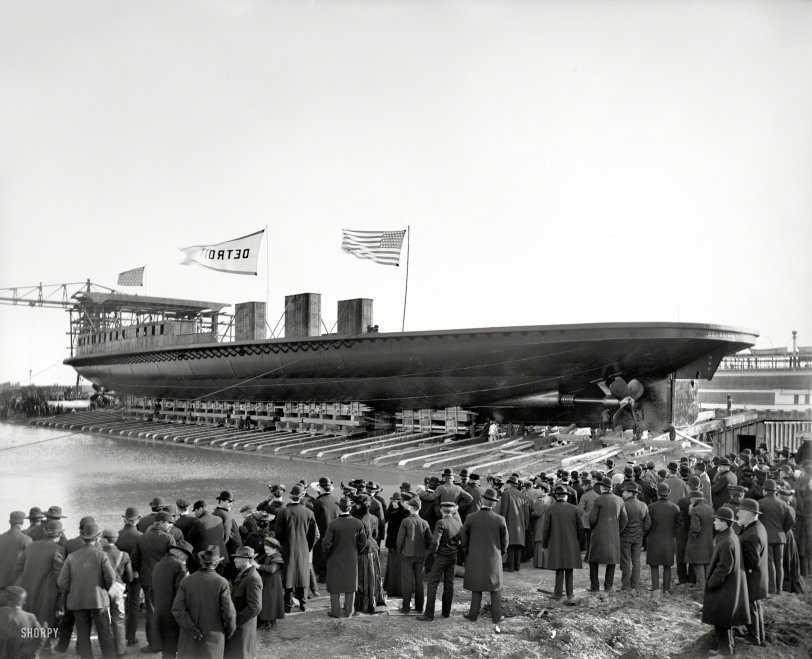


Framed or unframed, desk size to sofa size, printed by us in Arizona and Alabama since 2007. Explore now.
Shorpy is funded by you. Patreon contributors get an ad-free experience.
Learn more.

- Lofty addition
- In 1912
- Keenan Building
- Six years old
- Taken from the P.J. McArdle Roadway?
- It stood only 47 years
- Three track mind
- Incline to the right
- Reach for the sky, 1912 style
- No clean sweep
- Same Job Title, Same Face
- Sadly Lost
- Beautiful ...
- Where you get your kicks
- Aim High
- Pueblo Revival sisters
- Pueblo Neoclassicism
- Milk Man
- Regional dialect.
- Spielberg's inspiration
- Great Photo
- Loaf Story
- Do you still have the Rakes category?
- Could almost be a scene from the 1957 movie 'Hell Drivers'
- The Wages of Fear.
- Conspicuous by their absence
- Got Milk?
- All that aluminum
- No lefties
- Smoke 'em if you've got 'em
Print Emporium
Detroit on the Ways: 1904

November 1904. Ecorse, Michigan. "Great Lake Engineering Works. Steamer Detroit, Michigan Central Transfer, before the launch." The giant railcar ferry seen here. 8x10 glass negative, Detroit Publishing Co. View full size.
The Actual Launch Process???
OK, I know that the hull is going to slide down the boards sideways into the water. There are even images here on Shorpy showing that happening. I think I can see some large blocks near the propeller on the right side that appear to be holding it in position and there are probably some in the middle and on the other end also. At actual launch time how is the hull released...
Is there some master release to move the blocks out of the way all at once? Not likely with the weight of the hull resting on the blocks.
Do the guys underneath with the sledge hammers knock the blocks out and then duck down as the hull slides over them? That sounds like a job that would certainly invalidate their life insurance. The timing on that would be difficult since they would all need to be released at the same time.
Is the hull held in place by a cable(s) on the other side and then released after the holding blocks are knocked out of position and hopefully the crew is out of the way?
Can someone shed some light on this process!
The Detroit
was unique among Detroit River ferries in that it had one fore & aft compound engine for each of its screws (four, two at each end). Each had cylinders of 24 and 48 inches, with a stroke of 33 inches, each rated at 900-ihp. The propellers, given the vessel's length and beam (308 feet, 61 feet) and its duty in ice are not unusual in the least. She was launched 12 November 1904 and entered service 13 January 1905 for the Michigan Central Railroad Company, operating between Detroit and Windsor, Ontario. After the MCRRCo opened its tunnel beneath the river in 1910, the Detroit was sold two years later to the Wabash Railroad Company, which operated it on essentially the same route. The vessel was reduced to a car float in 1969, and propelled by the tugs R. G. Cassidy or F. A. Johnson until her owner then, the Norfolk & Western, gave up the Detroit River service in 1991. The vessel was dismantled at Sandwich, Ontario, in 2009.
As for the funnels: The Detroit began with four, ran with three for the Wabash, and, while still self-propelled, ended with two.
That's what I call screw propulsion
The props seem enormous for the hull size (when compared to big ships of the 30s and 40s) and very coarsely pitched. Due to slow turning reciprocating engines perhaps??
Where are the stacks
that are billowing black oily smoke in the 1905 photo?
























On Shorpy:
Today’s Top 5